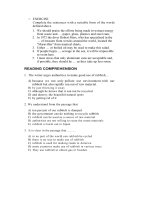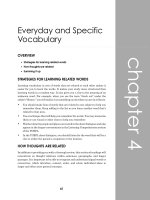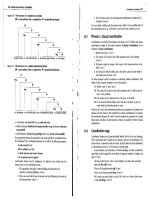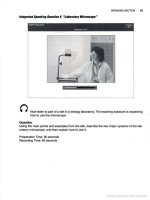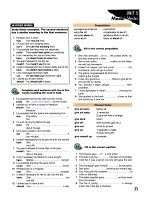Reading comprehension success part 11 pps
Bạn đang xem bản rút gọn của tài liệu. Xem và tải ngay bản đầy đủ của tài liệu tại đây (106.24 KB, 10 trang )
87
Language
and Style
I
n most of the passages you have read so far, the author’s ideas and intentions have
been very clear. But what happens when they’re not? What if the writer doesn’t pro-
vide a topic sentence that clearly expresses the main idea? Or what if the writer gives
you a poem instead of a clear-cut memorandum? How do you figure out what the author
is trying to say?
The good news is that no matter how cryptic a piece of writing may seem, the author
always leaves clues to help you figure out what he or she means. These clues can be found
in the writer’s language and style—the words used and the type of sentences in which he
or she uses them. The next four lessons, therefore, focus on four different aspects of lan-
guage and style:
■
Point of view
■
Diction
■
Style
■
To n e
You’ll learn how authors use these elements to create meaning for their readers. Then
you’ll put it all together in Lesson 15 to see how language, style, structure, and meaning
work together.P
icture this: You are walking along a tree-lined street late in the afternoon. Just ahead of you a
woman is sitting on a bench; a dog lies in the shade at her feet. You watch them and nod hello as
you walk by.
Now, picture this: You are that dog. You’re sitting in the shade under a bench next to your owner’s feet.
Suddenly, someone walks down the street in front of you. If you look up, you can see that person nod as he or
she walks by.
Although you’ve just pictured the same thing—a person walking by a woman with a dog—you’ve really
pictured two very different scenes, haven’t you? The scenario looks quite different from the dog’s point of view
than from the walker’s.
This shift in perspective happens in writing by changing the point of view. Point of view is one of the first
choices writers make when they begin to write, because it is the point of view that determines who is speaking to
the reader.
Point of view is the person or perspective through which the writer channels his or her information and ideas.
Just as we may look at a physical object from a number of different perspectives (from above it, below it, behind
it, beside it, and so on), we can look at information and ideas from different perspectives as well (mine, yours,
his or hers, the professor’s, the country’s, and so on).
LESSON
A Matter of
Perspective:
Point of View
LESSON SUMMARY
This lesson introduces you to the concept of point of view, one strategy writ-
ers use to convey their meaning to readers. Aspects such as whether writ-
ers use the more subjective I or the more objective one, whether they
address readers as you or merely refer to an anonymous they, influence how
readers understand what the writer has written.
11
89
Three Kinds of Point of View
When it comes to expressing point of view, writers can
use three distinct approaches:
■
First-person point of view is a highly individual-
ized, personal point of view in which the writer or
narrator speaks about his or her own feelings and
experiences directly to the reader using these pro-
nouns: I, me, mine; we, our, us.
■
Second-person point of view is another personal
point of view in which the writer speaks directly to
the reader, addressing the reader as you.
■
Third-person point of view is an impersonal,
objective point of view in which the perspective is
that of an outsider (a “third person”) who is not
directly involved in the action. There is no direct
reference to either the reader (second person) or
the writer (first person). The writer chooses from
these pronouns: he, him, his; she, her, hers; it, its;
and they, them, theirs.
All these points of view are available to writers,
but not all of them may be appropriate for what they’re
writing, and only one will create the exact effect a writer
desires. That’s because each approach establishes a par-
ticular relationship between the reader and the writer.
When Writers Use First Person
Imagine you get one of the following messages from
your company’s head office:
A. The company congratulates you on the birth of
your child.
B. We congratulate you on the birth of your child.
Which message would you rather receive?
Most of us would probably prefer to receive mes-
sage B over message A. Why? What is the difference
between these two messages? Both messages use the
second-person point of view, right? They both address
the reader as “you.” But you probably noticed that the
writers chose different points of view to refer to them-
selves. Message A uses the third-person point of view
(“the company”) whereas message B uses the first person
pronoun “we.” As a result, message B seems more sincere
because it comes from a person to a person rather than
from “the company” (a thing) to a person (you).
But those messages do more than just express
congratulations to the reader. They also seem to indi-
cate something about how the people in the head office
want to be perceived. In fact, their choice of point of
view shows whether they want to be seen as people
(“we”) or as an entity (“the company”). Read the mes-
sages again and then decide how you think each writer
wants to be perceived.
Which message seems to tell the reader, “We can
speak directly to you because we are real people behind
this company”?
Message ______
Which message seems to tell the reader, “We have
a very formal relationship; let’s not get too personal”?
Message ______
The company that sends message A suggests to
the reader that “We have a very formal relationship; let’s
not get too close or too personal.” Message B, on the
other hand, tells the reader something more like this:
“We can speak directly to you because we are real peo-
ple behind this company.” Thus, the point of view
reflects the way the senders of the message wish to be
perceived—as a distant entity (message A) or as
friendly colleagues (message B).
– A MATTER OF PERSPECTIVE: POINT OF VIEW–
90
Distance vs. Intimacy
Whether writers intend it or not (though they almost
always do), the third-person point of view establishes
a certain distance between the writer and the reader.
There’s no direct person-to-person contact that way
(me to you). Rather, with the third-person point of
view, someone (or something) else is speaking to the
reader.
The first-person point of view, on the other hand,
establishes a certain intimacy between the writer and
the reader. The writer uses I, my, mine, we, our, or us as
if expressing his or her own personal feelings and ideas
directly to the reader. “We congratulate you” makes
message B much more personal than message A, where
the company congratulates you.
■
First-person point of view establishes intimacy.
The writer wants to be close to the reader.
■
Third-person point of view establishes distance.
The writer wants to distance him- or herself from
the reader.
When Writers Use Third Person
In a business environment, it’s not always practical to
be personal. Though the first-person point of view
may make the reader feel close to the writer, the first-
person point of view also implies a certain subjectivity.
That is, the writer is expressing a very personal view
from a very personal perspective.
Subjectivity vs. Objectivity
There’s nothing wrong with expressing personal views,
but in the business world, writers may not always be at
an advantage using the first-person point of view.
They’re more likely to be taken seriously when they’re
objective, presenting things from an outsider’s point of
view, than when they’re subjective, presenting things
from their own possibly selfish or biased point of view.
■
Subjective: based on the thoughts, feelings, and
experiences of the speaker or writer (first-person
point of view)
■
Objective: unaffected by the thoughts, feelings,
and experiences of the speaker or writer (third-
person point of view)
Thus, if you wanted to complain about a new
office policy, which of the following points of view do
you think would be more effective?
A. I think our new office policy is a failure.
B. The new office policy appears to be a failure.
Most people would agree that sentence B is more
effective. The question is, why?
1. The point of view of sentence B is more effective
than that of sentence A because
a. sentence A is too subjective.
b. sentence B is too subjective.
c. sentence A is too objective.
d. all of the above.
The answer is a. Sentence A uses the first-person
point of view, and because I is so subjective and per-
sonal, it doesn’t carry as much weight as the objective
sentence B. In sentence B, there is no personal per-
spective; someone from the outside (a third person, not
the reader or the writer) is looking at the policy and
evaluating it. The third-person point of view is almost
always considered to be more objective because the
third person is not directly involved in the action. I,
however, is directly involved in the action (the policy)
and therefore cannot have an objective opinion about
the policy’s success or failure. I’s opinion may be prej-
udiced by the writer’s personal experience.
Of course, even when a writer uses third person,
he or she can still express his or her own opinion.
When that opinion is expressed in the third person,
however, it appears much more objective.
– A MATTER OF PERSPECTIVE: POINT OF VIEW–
91
When Writers Use
Second Person
When is you an appropriate pronoun? What effect does
it create for you, the reader? You generally is used to
address the reader directly, particularly when the writer
is giving directions. Imagine, for example, that you
have registered for a financial planning class at the local
community college. Prior to the first class, you receive
the following note:
Note A
As a student in our financial planning class, you will
need several items. First, you must purchase the
book Financial Planning: The Basics by Robin Wexel.
Second, you must outline your current financial sit-
uation by making a list of your income sources as
well as your bank accounts, investments, and retire-
ment plans. Finally, you should prepare a financial
wish list that documents where you would like to see
yourself financially ten years from now. You should
be as specific as possible when putting this list
together.
Now, imagine you receive this note instead:
Note B
Students in our financial planning class will need
several items. First, they must purchase the book
Financial Planning: The Basics by Robin Wexel. Sec-
ond, they must outline their current financial situ-
ation by making a list of income sources as well as
bank accounts, investments, and retirement plans.
Finally, they should prepare a financial wish list that
documents where they would like to see themselves
financially ten years from now. They should be as
specific as possible when putting this list together.
Which note would you rather receive? _____
Most likely you’d rather receive note A. Now,
here’s the tougher question:
2. The point of view of note A is more effective
than the point of view of note B because
a. note A feels less formal.
b. note A speaks personally to the reader.
c. note A addresses the reader as an individual.
d. all of the above.
Most people would prefer note A for all of these
reasons, so the answer is d. First of all, in note A, the
writer speaks directly to the reader (you). In note B,
the writer speaks in the third person (“students”); the
note never acknowledges that you are a student. As a
result, note B sounds more formal or official. The sec-
ond-person point of view, however, addresses you
personally. It singles you out as an individual, not as a
category (student). It is almost like note A was written
just for you.
Second Person and Audience
In fact, because note A uses the second-person point of
view, you can make certain assumptions about the
audience for this note. Reread note A and then answer
this question:
3. Note A was most likely written for
a. students considering the financial planning
class for next year.
b. instructors at the school.
c. students enrolled in the financial planning
class only.
d. all students at the community college.
Because note A uses the second-person pronoun
you, you can assume that it is written for c, only stu-
dents enrolled in the financial planning class. It must
be, because it can’t work for any other audience because
of its pronoun.
– A MATTER OF PERSPECTIVE: POINT OF VIEW–
92
Note B, on the other hand, could be used for a
much larger audience. In fact, the note could be a
description in a course catalogue designed for all stu-
dents at the college as well as the general public. So, the
third-person point of view may have been used in note
B not to create a distance between the reader and the
writer, but to allow for a wider audience.
Writers may also use you to make readers feel as
if they are taking part in the action or ideas being
expressed in the text. For example, let’s imagine that a
writer wants to convince readers in a particular town
that a community garden is a good idea. The writer
could use the third-person point of view as in the fol-
lowing paragraph:
Paragraph A
Imagine how wonderful it would be if local
residents had access to a community garden. Rather
than gardening in isolation, residents would come
together in an appealing designated spot to plant a
bountiful garden. They would be given a plot of
land within the large garden to plant as they see fit.
They could plant flowers, vegetables, herbs, or any
other greenery they desire. The requirement would
be that they spend at least one hour in the garden
every week and that they bring a few gardening
implements to share, such as watering cans, gar-
dening gloves, fertilizer, and shovels. The benefits of
a community garden would be numerous. Residents
would have access to land to garden they might not
otherwise have. They would be part of a worthwhile
and rewarding community activity that would allow
them to meet other residents who love gardening
and who might have excellent gardening skills and
hints to share. Additionally, a community garden
would be a wonderful oasis in the middle of our busy
town where residents can come to walk, sit, or just
enjoy the company of neighbors in a lush and
friendly setting.
Or, the writer could use the second-person point
of view to express the same ideas:
Paragraph B
Imagine how wonderful it would be if you had
access to a community garden. Rather than garden-
ing in isolation, you would come together in an
appealing designated spot to plant a bountiful gar-
den. You would be given a plot of land within the
large garden to plant as you see fit. You could plant
flowers, vegetables, herbs, or any other greenery you
desire. The requirement would be that you spend at
least one hour in the garden every week and that you
bring a few gardening implements to share, such as
watering cans, gardening gloves, fertilizer, and shov-
els. The benefits of a community garden would be
numerous. You would have access to land to garden
you might not otherwise have. You would be part of
a worthwhile and rewarding community activity
that would allow you to meet other residents who
love gardening and who might have excellent gar-
dening skills and hints to share. Additionally, a com-
munity garden would be a wonderful oasis in the
middle of our busy town where you can come to
walk, sit, or just enjoy the company of neighbors in
a lush and friendly setting.
Did you notice the differences between the para-
graphs? What pronouns does each paragraph use?
4. Paragraph A uses
a. first-person pronouns (I, we).
b. second-person pronouns (you).
c. third-person pronouns (he, she, they).
5. Paragraph B uses
a. first-person pronouns (I, we).
b. second-person pronouns (you).
c. third-person pronouns (he, she, they).
– A MATTER OF PERSPECTIVE: POINT OF VIEW–
93
Paragraph A uses the third person (c), while para-
graph B uses the second person (b). Now, which para-
graph do you find more convincing? Most people
would be more convinced by paragraph B. Why?
6. Paragraph B seems more convincing because
a. you puts the readers into the action of the
paragraph.
b. you makes readers pay more attention.
c. you makes readers imagine themselves in that
situation.
d. all of the above.
The second-person point of view does all of these
things (d), and that’s why it is often more convincing
than the other points of view. The second-person point
of view puts you, the reader, directly into the situation.
As soon as you read that word you, you start to pay
extra attention because the writer is addressing you
directly. And you can’t help but imagine yourself enjoy-
ing the benefits of a community garden because the
writer puts you in each scenario. The writer of this
paragraph knows that if you imagine yourself in these
situations, you are much more likely to see the benefits
of a community garden.
Summary
You can see by now how important point of view is in
writing, for each point of view creates a certain effect.
Sometimes, it brings the reader and the writer closer
together; sometimes, it pushes them apart. Some-
times, it makes an argument more convincing
through third-person objectivity; sometimes, an argu-
ment is more convincing through second-person
involvement; and sometimes, it’s more convincing
through first-person intimacy. Writers choose their
point of view carefully in order to create a certain
relationship both with their ideas and with the reader.
– A MATTER OF PERSPECTIVE: POINT OF VIEW–
94
■
Imagine you have an argument with someone. Tell the story of the argument, first from your point of view
using the first-person pronoun. Then, tell the story from the other person’s point of view, again using
the first-person pronoun. Finally, tell the story from an outsider’s point of view using the third-person
pronoun. Notice how the story changes when the point of view changes, and notice how both first-
person accounts will be subjective, while the third-person account is objective.
■
Take a memo or letter you received at work. If the information addresses you in the second person you,
change it to a third-person point of view (employees, managers, clients). Or, if the writer uses the first-
person point of view (I or we), change that to the third-person point of view to eliminate the subjectivity.
Skill Building until Next Time
W
hat made Sherlock Holmes such a good detective? Was he just much smarter than everyone else?
Did he have some sort of magical powers? Could he somehow see into the future or into the
past? No, Sherlock Holmes was no medium or magician. So what was his secret?
His powers of observation.
You may recall that the introduction to this book talked about active reading. As an active reader, you should
have been marking up the passages you’ve read in this book: identifying unfamiliar vocabulary, underlining key
words and ideas, and recording your reactions and questions in the margin. But there’s another part of active read-
ing we haven’t talked about: making observations.
LESSON
Diction:
What’s in a
Word?
LESSON SUMMARY
Today’s lesson focuses on diction, the words writers choose to con-
vey their meaning. The smallest change in choice of words can signif-
icantly change the tone and meaning of a passage. Today’s lesson
shows you how to pick up on the clues to meaning writers give through
their choice of words.
12
95
Making Observations
Making observations means looking carefully at the
text and noticing specific things about how it is written.
You might notice, for example, the point of view the
author has chosen. You could also notice:
■
Particular words and phrases the writer uses
■
The way those words and phrases are arranged in
sentences and paragraphs
■
Repeated word or sentence patterns
■
Important details about people, places, and things
When you make observations, you can then make
valid inferences. As a matter of fact, you did this in Les-
son 11 when you made assumptions about how the
writer wanted to be perceived based on the point of
view he or she used.
Observations and Inferences
Inferences, as you may recall, are conclusions based
on reason, fact, or evidence. Good inferences come
from good observations. The observations are the evi-
dence for the inferences. Good inferences—ones based
on careful observation—can help you determine
meaning, as they helped Sherlock Holmes solve crimes.
To be better readers, then, we need to be more like
Sherlock Holmes: We need to be better observers. In the
story “The Adventure of the Blanched Soldier,” Sher-
lock Holmes tells a client: “I see no more than you, but
I have trained myself to notice what I see.” You don’t have
to be Einstein to be a good reader; you just have to train
yourself to notice what you see.
Observing Diction
Test your observation skills on these two sentences:
A.The town’s new parking policy, which goes into
effect on Monday, should significantly reduce
traffic congestion on Main Street.
B. The town’s draconian new parking policy, which
goes into effect on Monday, should significantly
reduce traffic congestion on Main Street.
You don’t need Sherlock Holmes’s magnifying
glass to see the difference between sentence A and sen-
tence B: B uses the words draconian and new to describe
the parking policy, while A uses only new.(Go back to
Lesson 3 if you’ve forgotten what draconian means.)
Now that you have noticed this, why is it important?
1. What does sentence B tell you that sentence A
doesn’t?
a. what type of policy is being discussed
b. how the writer feels about the policy
c. when the policy begins
The answer is b. Both sentences tell you that the
policy is a new parking policy, and both say that the
policy goes into effect on Monday. But sentence B,
because it adds the word draconian, tells you how the
writer feels about the new policy: He doesn’t like it. His
opinion is implied through his choice of the word dra-
conian. Rather than directly saying, “I think the policy
is very severe,” the writer suggests or implies that this is
the way he feels.
– DICTION: WHAT’S IN A WORD?–
96


